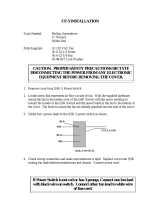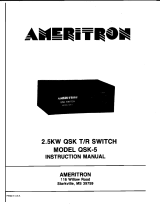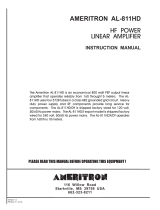Page is loading ...

MFJ-216 Instruction Manual Deluxe Amplifier Saver
MFJ-216 Deluxe Amplifier Saver
The MFJ-216 Deluxe Amplifier Saver relieves temperature related stress on
amplifiers, tuners, and dummy loads while allowing proper system adjustments.
It allows amplifiers to be properly adjusted without the use of long steady
carriers.
The MFJ-216 Deluxe Amplifier Saver allows tuning of an amplifier with full
required drive from the transceiver without over-heating the finals or anything
else in the RF line. It sends a series of pulses to the transceiver allowing the
peak power to be high enough to drive the amplifier to full power, but with the
average power being low enough not to over-heat the final(s).
The MFJ-216 Deluxe Amplifier Saver works with any solid state amateur
transceiver or transmitter, and all other equipment using positive keying line
voltages below 50 volts open circuit and 100 mA closed key current. It can also
be used with negative voltage key lines (commonly found in older tube type
radios) provided keying voltages are below 25 volts dc open circuit.
The MFJ-216 Deluxe Amplifier Saver is a valuable troubleshooting and
diagnostic aid. The MFJ-216 Deluxe Amplifier Saver can be used in
performance tests of QSK systems, watt meters, and other equipment.
The MFJ-216 Deluxe Amplifier Saver uses a single 9-volt battery for power,
with battery life dependent on operating and storage time. To install the battery
remove the cover by removing the two screws (one on each side) that secure it.
A battery clip and holder, located on the left side of the enclosure, are provided
for installing the 9-volt battery.
Technical Description
The MFJ-216 Deluxe Amplifier Saver uses a 555 timer driving an FET open
drain switch. Two front panel controls allow independent adjustment of both
pulse repetition rate (PULSE RATE) and on-to-off time duty cycle (DUTY
CYCLE).
PULSE RATE is adjustable from about 17 to 40 pulses per second, while
DUTY CYCLE is adjustable from about 10 to 90 percent. The keying time
intervals are typically adjustable from 2- 40 mS "on" time, and a 24 to 60 mS
pulse repetition time interval.
Minimum duty cycle and the slowest PULSE RATE occur at the full
counterclockwise settings of both front panel controls.
1

MFJ-216 Instruction Manual Deluxe Amplifier Saver
The CARRIER button is a momentary contact switch that temporarily locks the
transmitter in a continuous carrier transmit mode.
The PULSE button is a latching switch that activates the pulse circuit when
pressed in and locked.
Speech Duty Cycle
The duty cycle of average power to peak envelope power varies widely in the
real world. Every voice and system varies, no universal duty cycle of peak to
average power applies to the many real-world combinations of voices and
equipment.
Unprocessed speech usually has an average power between one percent and ten
percent of peak envelope power. Sustained speech, such as a long "hello",
produces average power levels that typically range from 10 to 30% of PEP.
Heavy speech processing increases the average power, pushing the short term
average power of normal speech to 30% or more.
During normal voice operation, most equipment heat is generated by the
quiescent current required to make the transmitting system linear. Proper
amplifier or transmitter tuning require adjustments at maximum peak power,
generally with maximum available drive from the exciter. A continuous tone or
carrier is generally used during adjustment, and the amplifier is generally tuned
for maximum output.
The continuous single tone carrier, commonly used to adjust the PA or tuner,
will raise heat significantly. The MFJ-216 Deluxe Amplifier Saver allows
proper tuning while driving the PA with a low duty cycle wave form. It is NOT
necessary to use a peak reading meter when adjusting an amplifier or tuner with
the MFJ-216 Deluxe Amplifier Saver, although the lack of a true peak reading
meter will prevent you from knowing the amount of peak power produced.
PULSE RATE and DUTY CYCLE
The MFJ-216 has two front panel controls labeled Pulse rate and duty cycle. As
indicated by the names, these controls adjust the rate at which the transmit
keying pulses occur (pulse rate), and the ratio of on- to-off time (duty cycle).
Some care must be used to insure PULSE RATE is slow enough, and the DUTY
CYCLE is long enough, to be within the keying response limits of the exciter
2

MFJ-216 Instruction Manual Deluxe Amplifier Saver
and meter. If the pulse rate is too fast and/or the duty cycle is too long, the
pulses will blur into one long steady signal.
The typical exciter has a leading edge rise time and tailing edge decay time of a
few milliseconds. This stretches the pulse duty cycle out, making the actual RF
envelope have a longer duty cycle than the actual keying wave form from the
MFJ-216. Because of this effect, the MFJ-216 Deluxe Amplifier Saver may
actually produce a 100% duty cycle wave form at high (clockwise) PULSE
RATES with longer (clockwise) on-time DUTY CYCLE settings.
If the pulse rate is too slow and/or the duty cycle too slow, peak power will not
be reached. All exciters have a delayed response to the leading edge of the
keying wave form. This delay may prevent full peak power from being reached
if the duty cycle is too short. Most peak meters have limited response time, this
causes lower power readings with short duty cycle pulses.
Another problem is nearly all meters have limited storage time, causing the
meter to "fall-back" during the time interval between RF pulses. To obtain the
most accurate meter readings, both PULSE RATE and DUTY CYCLE should
be set far enough clockwise to allow maximum peak power to be indicated on a
scope or peak reading meter.
Some peak meters do not read true peak power at all, instead reading something
less than the true peak power. If your meter reads less power when the pulser is
used, compared to the power when a steady or near steady carrier is produced,
your meter is probably not a good peak reading meter. Nearly every radio and
amplifier produces more peak power than steady carrier power, because of ALC
response time and power supply voltage sag under load. Too much duty cycle
on-time can cause unwanted component heating.
The ideal compromise (especially for tuning amplifiers) is achieved when the
PULSE RATE and DUTY CYCLE controls are near the counter-clockwise end
where the power drops off, but adjusted slightly clockwise from the point where
the peak power meter starts to fall back. If such a setting can not be found, it is a
strong indication the meter does not indicate peak power accurately.
3

MFJ-216 Instruction Manual Deluxe Amplifier Saver
Connecting the MFJ-216 Deluxe Amplifier Saver
The MFJ-216 Deluxe Amplifier Saver connects to the CW Key jack of your
exciter via the rear panel jack labeled "Output". The Output jack is a standard
RCA phono plug, with the center pin connected to the positive voltage keying
line (less than 50 volts and 100 mA) and the outer shell grounded. If the case
of the MFJ-216 Deluxe Amplifier Saver is kept isolated from ground, the MFJ-
216 Deluxe Amplifier Saver can be used with negative keying line voltage
radios provided radio keying line voltages are below 25 volts. The primary
concern is the shock hazard and potential of accidentally keying the rig if the
cabinet of the MFJ-216 Deluxe Amplifier Saver or the operator comes in
contact with grounded equipment.
WARNING:Never use the MFJ-216 with negative keying line rigs
that have over 25 volts on the key jack.
Tuning Amplifiers
Nearly all power amplifiers (PA's) are properly tuned when maximum envelope
power is obtained with full exciter output. Tuning the amplifier to match exciter
peak power prevents gain compression (flat-topping), reduces splatter and
distortion, and reduces the chance of PA damage from arcing.
Maximum average power is directly related to (although considerably less than)
maximum peak power. While the lack of a good peak reading meter prevents
measurement of true peak power, virtually any RF power meter will provide a
correct indication of tuning. When the amplifier is tuned to produce maximum
average power when driven with a constant rate and duty cycle pulse, it is
almost certainly tuned for maximum peak power.
The least damaging and cleanest PA tuning condition generally occurs when the
PA is peaked slightly beyond maximum output, in a direction that OPENS or
UNMESHES the loading capacitor (this capacitor is sometimes called LOAD,
ANTENNA, COUPLING, or MATCHING).
Caution:Be very careful to avoid applying full drive power to the PA
without having the load control open far enough. When power
amplifiers are under coupled, tank voltages can be extremely
high. This may cause tank components, such as the band switch
or tuning capacitor, to arc and fail. It also stresses the tube and
other components with needlessly high voltages. The MFJ-216
Deluxe Amplifier Saver will NOT prevent voltage damage to
components.
4

MFJ-216 Instruction Manual Deluxe Amplifier Saver
Adjust the two front panel controls to a 10 o'clock position. With the amplifier
in stand-by, push the Carrier Tune button and adjust the transceiver's power
control to the rated drive power of the amplifier. Place the amplifier into
operate mode and depress the pulse tune button on the MFJ-216 Deluxe
Amplifier Saver. Tune the amplifier for peak output power.
Note
: Due to the response time of most non-peak-reading RF watt meters, the
meter will read a low average power, but the amplifier will be tuned for
full peak power.
While momentarily pressing the carrier tune button, the RF watt meter should
read full power of the amplifier. The amplifier is now tuned for full power.
For best linearity, it is best to reduce the transceiver's power slightly after tuning
the amplifier.
Testing QSK Systems
The MFJ-216 Deluxe Amplifier Saver can be used to evaluate QSK systems. In
one test configuration, a continuous signal source is loosely coupled to the
dummy load. The receiver is tuned to this signal source, and the MFJ-216
Deluxe Amplifier Saver controls are adjusted until the test signal is clearly
audible. The maximum QSK receive speed is found by measuring the PULSE
RATE, and multiplying the PULSE RATE by 2.4. The DUTY CYCLE should
be set for normal sounding CW dots during this test, or a 1:1 ratio.
The transmission wave shape can be checked by looking at the RF output on a
scope, with the scope triggered or synchronized to the keying line signal. A
normal CW signal has a smooth rise and fall time of about one millisecond, with
no overshoot or undershoot. Switching from manual operation to full QSK
should not disturb the keying wave form, or change the on and off time period.
Testing Watt meters
Watt meters can be tested by measuring the single tone power with a barefoot
exciter running off of a regulated supply, and adjusting an oscilloscope to read
near full screen with that carrier. By activating the MFJ-216 with the PULSE
RATE set approximately mid-range, and adjusting the DUTY CYCLE control
until the full peak envelope voltage is just displayed on the scope, the meter can
be evaluated. A good peak reading meter should indicate the same amount of
peak power with the MFJ-216 pulsing the carrier as it indicates with a
continuous carrier, as long as the maximum scope deflection remains the same.
5

MFJ-216 Instruction Manual Deluxe Amplifier Saver
RFI and TVI Troubleshooting
The MFJ-216 Deluxe Amplifier Saver can be used to activate the transmitter
with a pulsed signal of full peak power, without undue equipment heating. This
will allow you to move to the location of the device being interfered with, while
safely operating the transmitter at high power.
You can add filters, grounds, and move cables on the device being interfered
with without fear of overheating your transmitter. The short duty cycle also
reduces interference to other amateur operators.
Be sure to have a licensed operator attending your station, and to conform to all
FCC rules regarding CW emissions.
Technical Assistance
If you have any problem with this unit first check the appropriate section of this
manual. If the manual does not reference your problem or your problem is not
solved by reading the manual you may call MFJ Technical Service at 662-323-
0549 or the MFJ Factory at 662-323-5869. You will be best helped if you have
your unit, manual and all information on your station handy so you can answer
any questions the technicians may ask.
You can also send questions by mail to MFJ Enterprises, Inc., 300 Industrial
Park Road, Starkville, MS 39759; by Facsimile to 662-323-6551; or by email to
explanation of exactly how you are using your unit, and a complete description
of your station.
6

MFJ-216 Instruction Manual Deluxe Amplifier Saver
Schematic
7

MFJ-216 Instruction Manual Deluxe Amplifier Saver
Parts List
Designator Description P/N
R3, R4 Resistor, 1K OHM 100-3100
R5 Resistor, 10K OHM 100-4100
R1 Resistor, 47K OHM 100-4470
R6, R7 Resistor, POT, 500K OHM 155-5500-1
C1, C3 Capacitor, .01uF 200-0004
C2, C4 Capacitor, .1uF 200-1017
D1, D2, D3 Diode, 1N4148 300-0003
D4 Diode, 1N4007 300-1005
Q1 FET, 2N7000 305-7000
U1 IC, Timer, NE555CN 311-1003
SW1 Switch, Locking, 2P2P 504-2022
SW2 Switch, Momentary., 2P2P 504-2022M
J1 Jack, RCA Phono 600-1325
8
/













